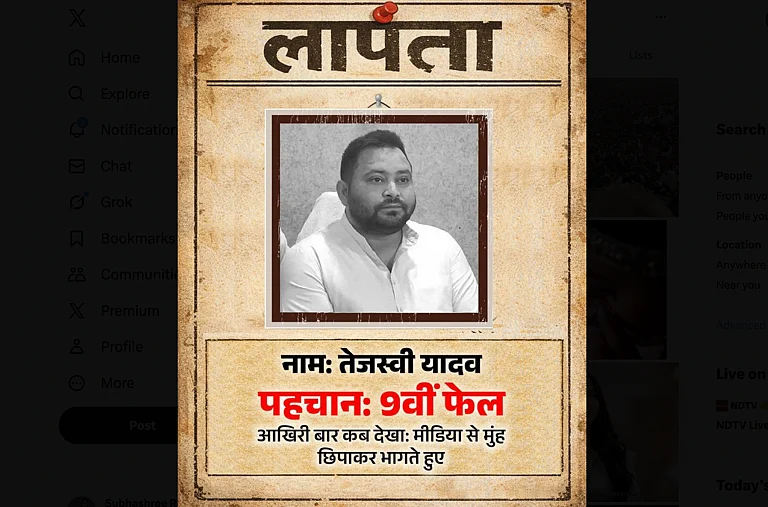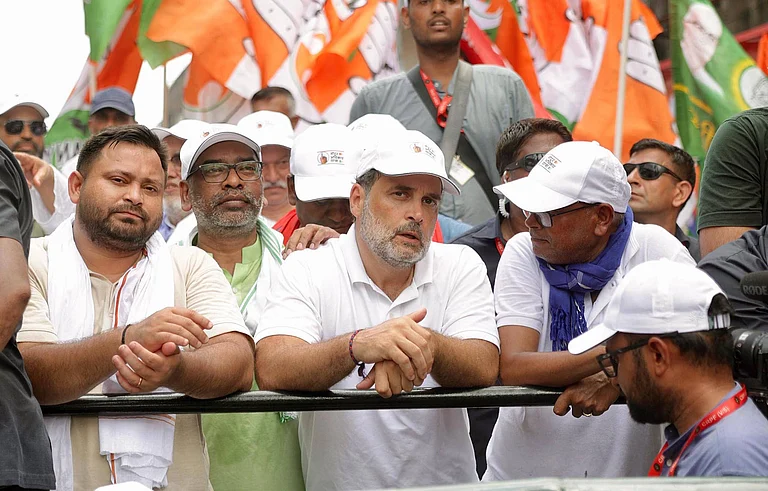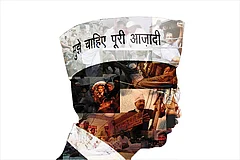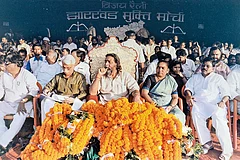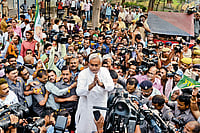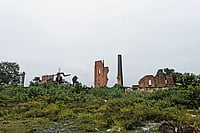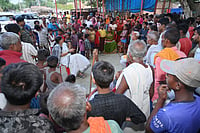Lalu Prasad Yadav’s political journey from “Gopalganj to Raisina” has been a colourful one; as colourful as his personality. His early life in Phulwaria village in Gopalganj district of Bihar was confined to farming and buffalo rearing, but it did not take long for him to transform into a dynamic politician who has walked through some of the most powerful corridors of the country.
He was just six when he was sent to Patna where his elder brothers were working at the Patna Veterinary College. He completed his matriculation from a local school and joined BN College. It was the early seventies. Student politics was on the boil and Lalu Yadav got drawn to it.
He entered mainstream politics in 1975. Socialist icon and Bihar chief minister Karpoori Thakur was instrumental in getting him a Lok Sabha ticket in the 1977 elections. At 29, Lalu Yadav became a parliamentarian.
The Seeds of RJD’s Inception
The year 1996-1997 was a turbulent one for Lalu Yadav, but the turbulence paved the way for the formation of the Rashtriya Janata Dal (RJD), which ruled Bihar for the next nine years.
Lalu Yadav was named prime accused in the fodder scam that was traced back to 1978 when Shyam Sundar Das was the chief minister of the state. He was interrogated by the Central Bureau of Investigation (CBI). The then CBI director informed the media that the agency had ample evidence to file a charge sheet. The arrest was imminent.
In the meantime, scores of Janata Dal leaders mounted pressure on him to resign from the chief minister’s post. But Lalu was adamant. After all, he was the protagonist of the consecutive wins of the party in Bihar.
The election for the post of national president of the Janata Dal was due and Sharad Yadav decided to contest for the post against Lalu Yadav, who was the national president of the party. A product of Jai Prakash Narayan’s (JP) sampurna kranti (total revolution), Lalu Yadav was cornered.
The CBI wrote to governor A R Kidwai on June 17, 1997, to give permission to file a charge sheet against Lalu Yadav, which was granted. There was no way out for Lalu. Things went further south when Janata Dal leaders Sharad Yadav and Ram Vilas Paswan issued a public statement asking Lalu to resign.
In his biography Gopalganj to Raisina, Lalu Yadav writes: “The party had been winning under my leadership. Janata party had won for the second time in Bihar. It was in power at the Center. They (Janata party leaders) should have supported me but they wanted me to step down from the post of national president as they had personal ambitions.”
He attended a dinner meeting hosted by I K Gujral in New Delhi on July 4, 1997. The very next day, he left the Janata Dal with 18 Lok Sabha members and six Rajya Sabha members and formed a new party—the RJD—on July 5.
Lalten (lantern) became the symbol of the newly-formed RJD, but it was not the first choice. “Earlier, the proposed symbols were related to farming, but all the symbols were already taken, so we approached the Election Commission,” says Shyam Rajak, a close aide who has been with Lalu Yadav since the Janata Dal days. “We wanted a symbol with which even illiterate people in remote villages would be able to relate to. There was no electricity in those days, and lanterns were widely used. Hence we went with lantern,” he adds.

The Rabri Devi Era
Although the RJD had sufficient number strength as well as a strong vote bank, the party was also in conflict with the Centre.
Just two weeks after the establishment of the RJD, Lalu Yadav resigned in the wake of the fodder scam and made his wife, Rabri Devi, the chief minister. Just 18 months after she took over, massive caste-based massacres took place in two villages within a span of two weeks, which shook the state. Taking advantage of this, the then Vajpayee government dismissed the RJD government and imposed President’s Rule in the state. The decision was opposed in the Rajya Sabha. Vajpayee did not have the numbers in the Rajya Sabha, due to which the proclamation was not passed, and President’s Rule had to be withdrawn.
After three weeks of President’s Rule, the RJD again formed the government and Rabri Devi became the chief minister.
When Lalu Yadav became the chief minister for the first time in 1990 while he was in the Janata Dal, he started strengthening his core vote bank of Dalits, Yadavs and Muslims. For the unity of Yadavs and Muslims, he, in a public meeting at the Gandhi Maidan, had said: “From now on, the Yadavs will protect Muslims in the event of communal violence. It does not matter if 10 Yadavs die saving the life of one Muslim brother.”
The basic ideology of the party was social justice and secularism, which was demonstrated on many occasions. Whenever any major incident happened involving his core vote bank, Lalu Yadav himself would reach the spot. During the Sitamarhi riots of 1992, he personally monitored the law and order situation and relief operations. He would often go to Dalit colonies and talk to the people. He would not hesitate to ask for food from Dalit women and always ate in their plates.
In 1997, a horrific caste massacre took place in Laxmanpur-Bathe of Arwal Assembly constituency. Five dozen people belonging to the Dalit caste were killed by armed forces of the dominant upper caste. Lalu Yadav was in jail in the fodder scam and Rabri Devi was the chief minister.
She reached the spot and talked to the victims’ families. Recalling the incident, Ravindra Singh, the then MLA from Arwal Assembly, says: “She would visit houses with a torch in her hand and see the dead bodies. The emotional tide of the victims of this massacre reached its peak after a woman was identified as one of the victims. Women would fall at her feet and start crying.”

How it Lost the EBCs and the Dalits
To keep the Dalits and Extremely Backward Class (EBCs) with him, the Lalu Yadav government abolished taxes for the Pasi community—people from this community extract toddy from palm trees. Under his tenure, many slums in state cities, including Patna, underwent redevelopment. He also made the violation of reservation rules in government jobs and educational institutions a cognisable offence.
Despite this, the RJD could not keep the Dalits and EBCs with it for long. The party kept focusing on the Muslims and the Yadavs.
Rajak, however, denies this. He says: “It was not only the Yadavs and the Muslims who were with the RJD. There were big leaders of upper castes and of backward classes and Dalits in the party. Lalu ji gave tickets to Dalits and backward classes in the MLC and Rajya Sabha elections. He used to tell the Yadavs in his speeches to protect the Dalits, backward classes and Muslims, but at the lower level, some arrogance had developed among the Yadavs, due to which the EBCs and Dalits turned their face from the RJD.”
In 1992, when he was the Chief Minister, Lalu Yadav emerged as a leader of great stature at the national level by stopping the Rath Yatra of Lal Krishna Advani in Samastipur and arresting him. He was also seen as a strong challenger to the Hindutva party. This incident brought Muslims closer to the RJD. In this way, Muslims and Yadavs became a strong vote bank of the RJD. Due to this vote bank, the RJD remained in power in Bihar till 2005.
In the October 2005 elections, the BJP’s upper caste vote and the JDU’s non-Yadav OBC, EBC and Muslim vote together defeated the seemingly unbeatable RJD. After this defeat, the RJD could not form the government in Bihar on its own. The party, though, remained with the United Progressive Alliance (UPA) headed by the Congress and enjoyed power at Centre.
In the 2009 General Elections, the RJD formed a fourth alliance with the Lok Janshakti Party (LJP), Samajwadi Party (SP) and other parties. The Fourth Alliance performed poorly. After around one decade of exile from the power corridor of Bihar, it bounced back in the 2015 Assembly Elections, albeit it fought with the JDU. But it lost power in 2017 when the JDU dumped it and formed a government with its former ally, the BJP.
Experts believe that Tejashwi Yadav’s outreach beyond the RJD’s core vote bank and youth will help the party increase its base. However, the Yadavs are a bit confused.
Challenges Ahead
The dependence on Yadav and Muslim vote banks limited the RJD’s political opportunities. Hence, it was necessary for the RJD to include everyone from the upper castes to the Dalits and the EBCs. Tejashwi Yadav, Lalu Prasad’s son, who now heads the party, feels that the party cannot succeed by confining its reach to Yadavs and Muslims only. This is why he often says that the RJD is a party of “A to Z castes”. During his recent Jan Vishwas Yatra, he said that the RJD is not only a party of MY (Muslims and Yadavs) but also of BAAP [Bahujan (Dalits), Agda (upper castes), Aadhi Abadi (women) and Pashmanda (backward sections of the Muslims)].
Experts believe that Tejashwi Yadav’s outreach beyond the RJD’s core vote bank and youth will help the party increase its base. “Ever since he took over the party command, Tejashwi has been trying to make the RJD a party of all. The unprecedented performance of the RJD and other partners of the Mahagathbandhan in the 2020 Bihar Assembly elections is proof that he has succeeded to some extent in breaking the shackles. But to what extent the other caste groups, especially the upper castes and the EBCs, come closer to the party will be seen in the coming days,” Awanish Kumar, assistant professor, Azim Premji University (Bengaluru) and keen observer of politics of Bihar, says. “He also went beyond caste by popularising the discourse of jobs for youth and we have seen the impact of this in the 2020 Bihar assembly elections. His discourse went beyond the state. This will further help the party to increase its vote base,” he added.
However, the RJD’s hardcore Yadav workers seem a bit confused as to how to react to the RJD outreach to upper castes. Pradip Yadav, a panchayat-level RJD worker, says: “Tejashwi Yadav is young and he is doing great. But, we should stick to the slogan jiski jitni sankhya bhari, uski utni hissedari (the larger the number, the greater the share). It should not be that 15 per cent of the population will enjoy 85 per cent share in power.”
(This appeared in the print as 'Maverick Politician')
MORE FROM THIS ISSUE
Umesh Kumar Ray is a bihar-based independent journalist










